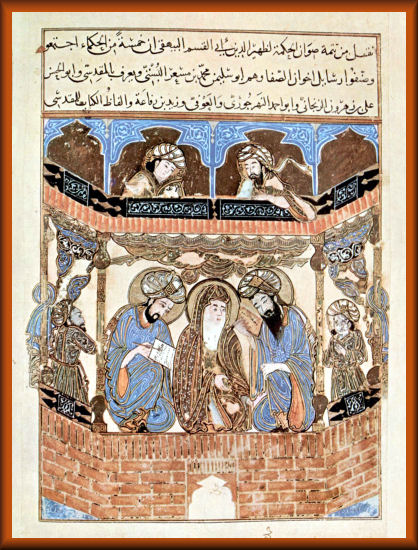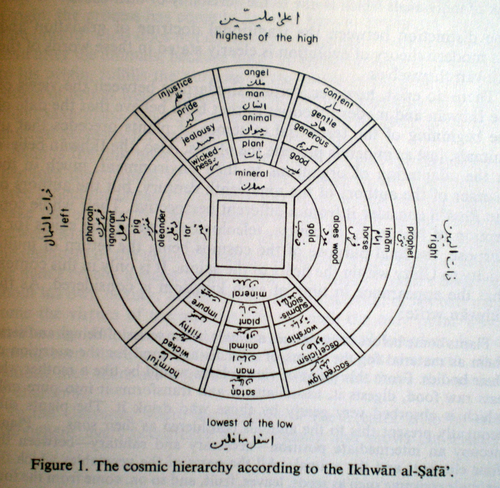Armahedi Mahzar (c) 2015
 |
| Algazel |
This is my surprising turn in my quest for logical simplicity. When I study Boolean logic I try to apply it to traditional logic of Aristotle. I was so disapointed when I read the validity proof of syllogism in George Boole book Laws of Thought, is very complex using strange terms like 1/0 or 0/0.
Aristotle saw his valid categorical syllogisms as implications. The Stoic saw hypothetical syllogisms and disjunctive syllogisms as implications. Implication is one way relation. It is not two way equivalence. Even Boole who wrote syllogistic premises and as equivalences did not know it.
However, the great Persian sufi al-Ghazali in the 11th century, see all syllogisms as a ballance. In other words, the conjuction of premises and the conclusion are logical equivalent to each other. He logically interpreted the word al-mizan in the holy book of Islam, al-Quran, as syllogism.
When I first read about it, I could not believe it, because I thought that inference is one way directed, But, later on, after discovering Boolean arithmologic, I found out that al-Ghazali is indeed true. Valid syllogism, in fact, is an equivalence. Nothing wrong in it.
This principle of implication is so simple such that its discovery made me astonished, because it is so simple but also so powerful. I will call it as the Algazel Principle. In this blog I will show you by illustrate its aplication to classical logic.
Arithmologic used arithmetical coding used by Boole in his algebra of logic. TRUE and FALSE is coded as 1 and 0 respectively. NOT x is coded as 1-x. x OR y is coded as addition x+y.
Boole coded x AND y as multiplication xy. But, using De Morgan Law, we can defined x AND y as NOT(NOT x OR NOT y) which can be coded as 1-(1-x+1-y)=x-1+y. So in arithmologic, AND is coded as -1+.
The interesting point with this arithmetic coding, the three fundamental principles of logic are becoming just algebraic identities. The principle of identity becomes x=x, the principle of excluded middle becomes x+1-x=1 and the principle of contradiction becomes x-1+1-x=0.
With this arithmologic the valid syllogism IF (all m is p) AND (all s is m) THEN (all s is p) is coded as 1-((1-m+p)-1+(1-s-m)+(1-s+p) which can immediately evaluated as 1 or TRUE. If it is not evaluated to 1 then it is not valid.
In general, a valid syllogism is a tautology. This fact can be used to prove Algazel principle as follow. If IF a AND b THEN c = TRUE is a valid syllogism, then its arithmologic coding is 1-(a-1+b)+c=1 which is equal to 1+c=1+(a-1+b) or c=a-1+b which is the code of c IS (a AND b).
So, logically, the syllogism is an equivalence. The conclusion IS the conjunction of its premises. It is so general, so it can be used to prove all stoic syllogisms is also equivalences as it is claimed by Algazel: the hypothetical and disjunctive.
In fact, Algazel principle is not only true for just syllogisms, it is true for any tautological inference for example the Leibniz Praeclarum Theorema and the Peirce Law. Proof: the tautological implication IF p THEN q is TRUE is coded as 1-p+q=1 or p=q which is an equivalence of consequent and antecedent.
The mystery is that Algazel did not know arithmologic, but in fact he know syllogism is equivalence. How could he know it? I think because he is a mystic and he know it by his mystical intuition seeing directly the Plato's world of mathematical ideas. So, anyway it seems to me that mysticism and mathematic are not contradicting each other.
The surprising fact is that so many mathematicians and logicians such as Aristotle, the Stoic logician, Leibnitz, Boole and Peirce did not recognize the Algazel Principle. It make me think that mystical contemplation can help mathematician or logician to discover more truths.
Aristotle saw his valid categorical syllogisms as implications. The Stoic saw hypothetical syllogisms and disjunctive syllogisms as implications. Implication is one way relation. It is not two way equivalence. Even Boole who wrote syllogistic premises and as equivalences did not know it.
Algazel Principle
However, the great Persian sufi al-Ghazali in the 11th century, see all syllogisms as a ballance. In other words, the conjuction of premises and the conclusion are logical equivalent to each other. He logically interpreted the word al-mizan in the holy book of Islam, al-Quran, as syllogism.
When I first read about it, I could not believe it, because I thought that inference is one way directed, But, later on, after discovering Boolean arithmologic, I found out that al-Ghazali is indeed true. Valid syllogism, in fact, is an equivalence. Nothing wrong in it.
This principle of implication is so simple such that its discovery made me astonished, because it is so simple but also so powerful. I will call it as the Algazel Principle. In this blog I will show you by illustrate its aplication to classical logic.
Arithmologic coding
Arithmologic used arithmetical coding used by Boole in his algebra of logic. TRUE and FALSE is coded as 1 and 0 respectively. NOT x is coded as 1-x. x OR y is coded as addition x+y.
Boole coded x AND y as multiplication xy. But, using De Morgan Law, we can defined x AND y as NOT(NOT x OR NOT y) which can be coded as 1-(1-x+1-y)=x-1+y. So in arithmologic, AND is coded as -1+.
The interesting point with this arithmetic coding, the three fundamental principles of logic are becoming just algebraic identities. The principle of identity becomes x=x, the principle of excluded middle becomes x+1-x=1 and the principle of contradiction becomes x-1+1-x=0.
Proving Algazel Principle
With this arithmologic the valid syllogism IF (all m is p) AND (all s is m) THEN (all s is p) is coded as 1-((1-m+p)-1+(1-s-m)+(1-s+p) which can immediately evaluated as 1 or TRUE. If it is not evaluated to 1 then it is not valid.
In general, a valid syllogism is a tautology. This fact can be used to prove Algazel principle as follow. If IF a AND b THEN c = TRUE is a valid syllogism, then its arithmologic coding is 1-(a-1+b)+c=1 which is equal to 1+c=1+(a-1+b) or c=a-1+b which is the code of c IS (a AND b).
So, logically, the syllogism is an equivalence. The conclusion IS the conjunction of its premises. It is so general, so it can be used to prove all stoic syllogisms is also equivalences as it is claimed by Algazel: the hypothetical and disjunctive.
Afternote
In fact, Algazel principle is not only true for just syllogisms, it is true for any tautological inference for example the Leibniz Praeclarum Theorema and the Peirce Law. Proof: the tautological implication IF p THEN q is TRUE is coded as 1-p+q=1 or p=q which is an equivalence of consequent and antecedent.
The mystery is that Algazel did not know arithmologic, but in fact he know syllogism is equivalence. How could he know it? I think because he is a mystic and he know it by his mystical intuition seeing directly the Plato's world of mathematical ideas. So, anyway it seems to me that mysticism and mathematic are not contradicting each other.
The surprising fact is that so many mathematicians and logicians such as Aristotle, the Stoic logician, Leibnitz, Boole and Peirce did not recognize the Algazel Principle. It make me think that mystical contemplation can help mathematician or logician to discover more truths.


 in the 70s of the last century write a strange book titled ‘Laws of
Form’. In this book he used CROSS
in the 70s of the last century write a strange book titled ‘Laws of
Form’. In this book he used CROSS 

 used the sixth consequence
used the sixth consequence simplified
the Brownian system into a Box Algebra based on single axiom (reductio
ad absurdum) also with the same algebraic inference rules. The axiom
actually is one of the three Huntington axioms. The other two axioms are
not necessary in a pictorial symbolization.
simplified
the Brownian system into a Box Algebra based on single axiom (reductio
ad absurdum) also with the same algebraic inference rules. The axiom
actually is one of the three Huntington axioms. The other two axioms are
not necessary in a pictorial symbolization.
